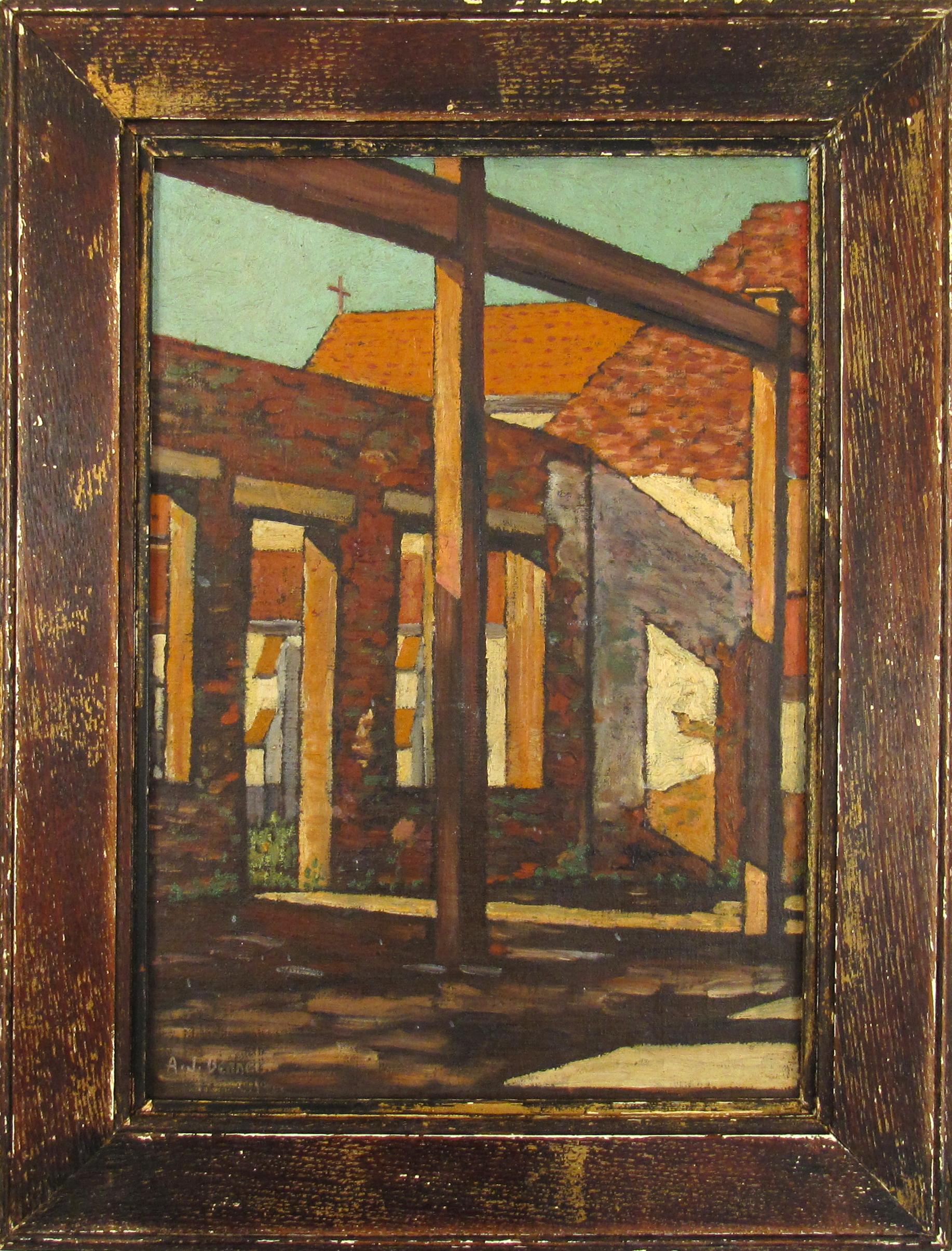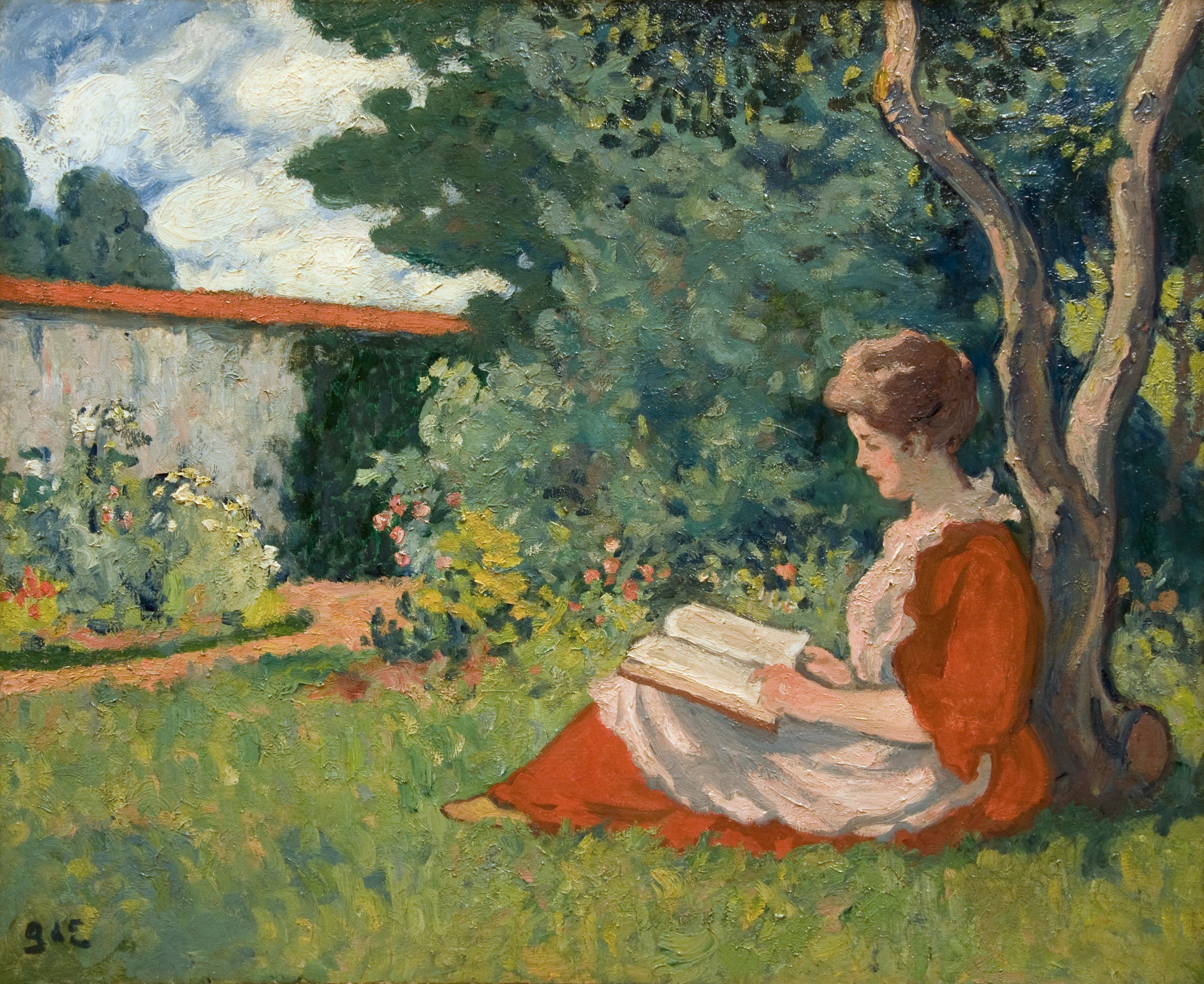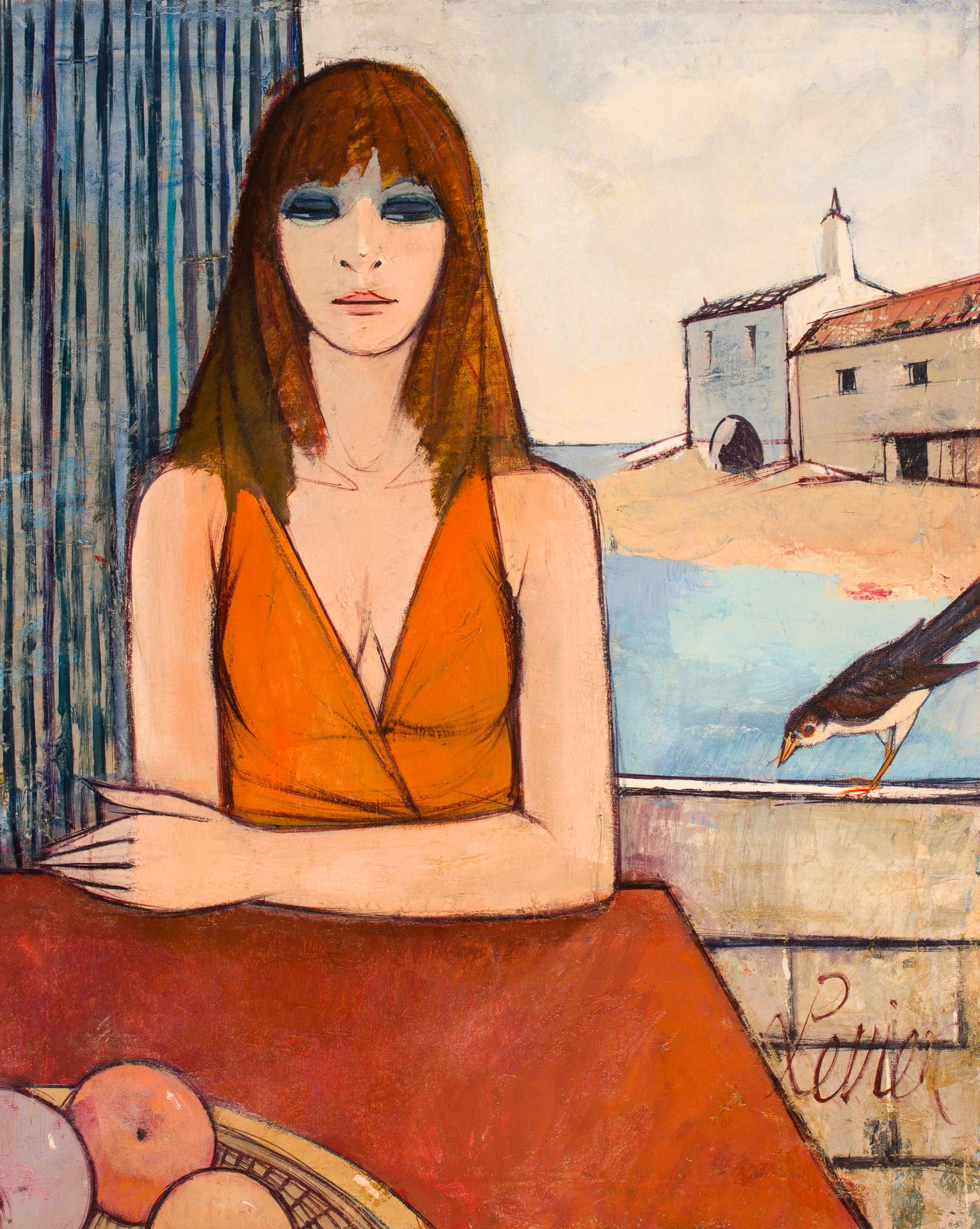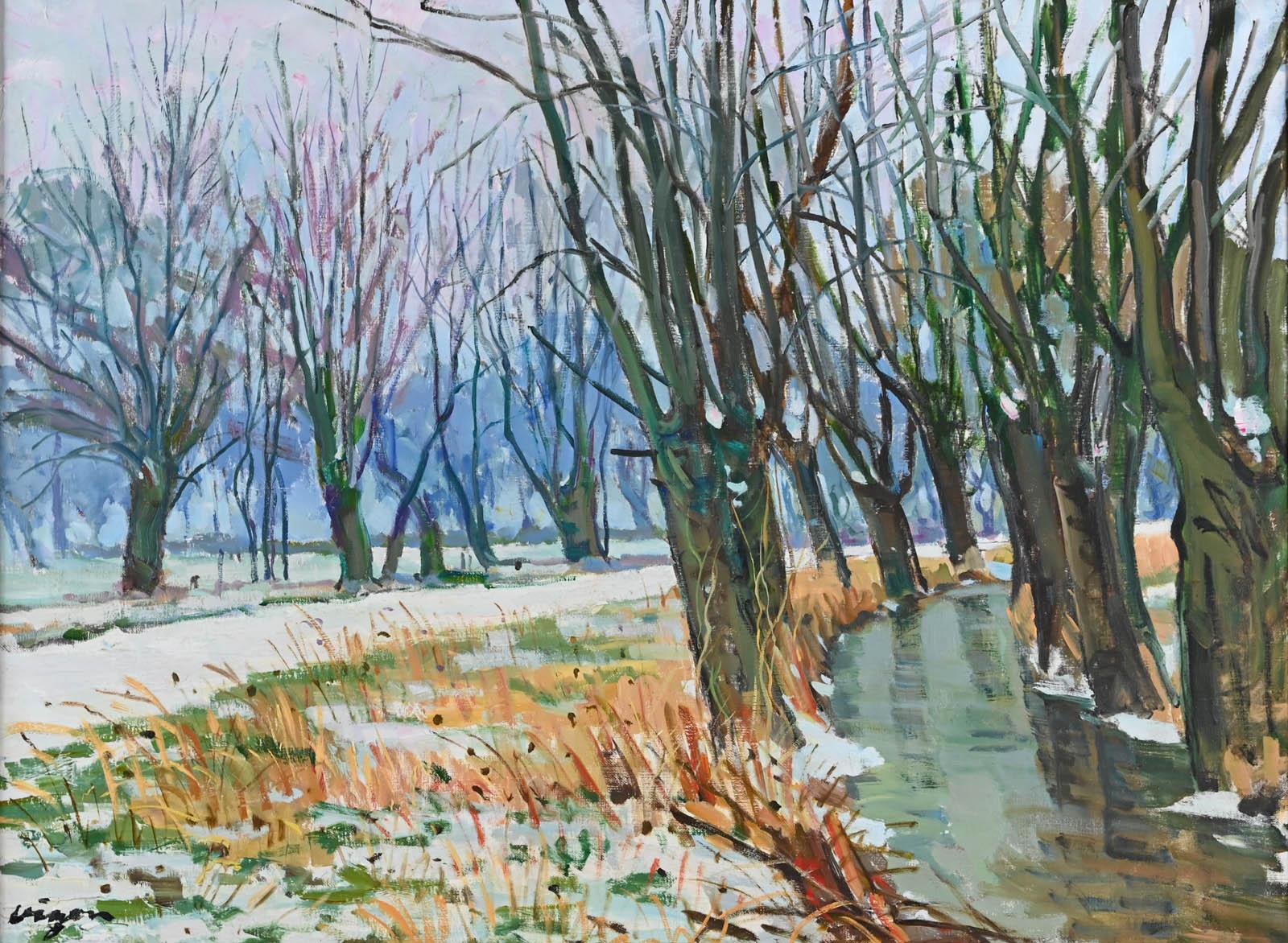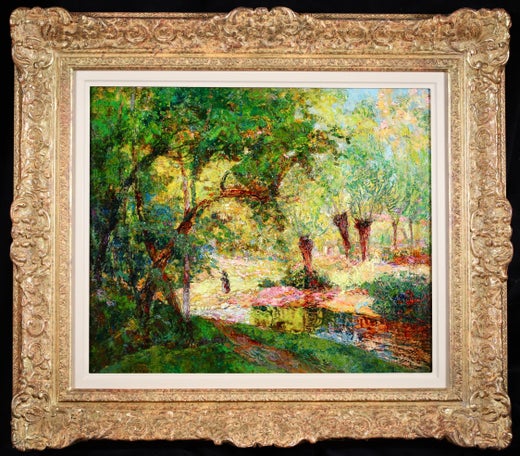Victor CharretonEmpreintes dans la neige - Post Impressionist Oil, Landscape by Victor Charretonc.1910
c.1910
About the Item
- Creator:Victor Charreton (1864-1937, French)
- Creation Year:c.1910
- Dimensions:Height: 33 in (83.82 cm)Width: 38 in (96.52 cm)
- Medium:
- Movement & Style:
- Period:
- Condition:Unlined original canvas - some small retouchings visible under UV.
- Gallery Location:Marlow, GB
- Reference Number:
Victor Charreton
Victor Charreton was the son of a surveyor. He spent his childhood in Chaumont and went to school in Bourgoin. In 1885 he began studying law at Grenoble University and in 1892 became a solicitor at the Lyons Court of Appeal. He had been creating paintings since childhood and was given advice by Ernest Hareux (he did not merely read his treatise on painting, which was highly regarded at the time) and also later by Louis Japy.
In 1902 Charreton gave up his legal career to devote his time to painting. The same year he moved to Paris. Every summer, from 1912 onwards, he would spend time at his house in St-Amant-Tallende near Clermont-Ferrand, where his wife came from. He also traveled abroad — to Algeria in 1905, to Spain and England in 1912 and to Belgium and Holland in 1913 — visiting numerous museums along the way. He also visited Corsica and Germany. He led the life of an aesthete and man of culture and was a lover of poetry and music. In 1914 he was made a Chevalier of the Légion d'Honneur.
Charreton was a landscape artist in the Lyons tradition with a love of sensual impasto. In his works he sought to capture fleeting, momentary effects, like those achieved by the Impressionists: effects at different times of day and in different seasons, such as dusk and snow. As a young man he painted the environs of Bourgoin, but his marriage in 1893 took him to Auvergne where he painted the characteristic landscapes of the region. Landscapes of Auvergne make up approximately two-thirds of Charreton’s output. What became known as the School of Murols, named after a village in Auvergne, was principally formed around him between 1910 and 1925. Skilled in capturing minute changes in the weather, he was also adept at capturing the spirit of new places.
Beside his native Dauphiné and his adopted Auvergne, Charreton was also charmed by the landscapes of the Île-de-France and Paris — Montmartre, the Jardin du Luxembourg and the Parc Montsouris — and also Provence, Creuse and Brittany. However, no trace has been found of his trips abroad. It would be a misjudgment to think that Charreton only painted pretty picture-postcard scenes in the regions he visited; on the contrary, he would seek out the intimist qualities of a place, choosing perhaps a quiet hamlet, with a humble bridge over an anonymous stretch of water, or an ordinary tree outside a tumbledown house.
Charreton would paint blazing autumn landscapes, with a sumptuous color palette, but also favored snowy scenes, their exact chromatic opposite. At the start of his career he would paint dusky scenes and contre-jours in halftones and misty sunsets. As Charreton’s artistic development progressed, he attached more and more importance to light and color. In this respect his work follows on from that of Ravier and, like Guillaumin, it is almost a precursor to Fauvism, or alternatively can be regarded as complicit with it, like the work of Maurice Marinot. Charreton’s brushwork evolved in tandem with his use of color, which became ever more vibrant; for example his fondness for purple hues and later his striking color contrasts. His brushwork became more conspicuous and he would suppress the insignificant details in order to bring out the forms that made up the general composition.
Among art historians Charreton is not ranked alongside the innovators who succeeded the Impressionists, like Gauguin, Seurat, Van Gogh or Cézanne. Older than Matisse, who was himself already by far the eldest of the Fauves, Charreton stopped short of what he considered to be their excesses. He placed himself at the crossroads between two centuries: the end of the century of Impressionism and the start of the leaps made by Fauvism. His life and the major themes in his work are evidence of this, but he decided to be a regional painter; as such, his talent and qualities are clearer than they may otherwise have been if he had chosen a more ambitious career. Beside his painting, he also wrote a play in three acts entitled The Montrouge Well (Le Puits de Montrouge), which was performed in Bourgoin in December 1883.
Charreton made his debut at the Lyons Salon in 1894 with Morning in Montpeyroux. That same year he began exhibiting in Paris at the Salon of the Société des Artistes Français, showing October Evening. He was awarded an honorable mention in 1910, a silver medal in 1912, a gold medal in 1913 and a commendation outside the competition in 1914. He also became a member of the committee and the jury and exhibited there until his death.
Charreton took part in collective exhibitions in France — in Toulouse, Clermont-Ferrand, Roubaix and Bordeaux — and abroad, in New York, Geneva and Barcelona. In 1915 he held a solo exhibition at the Galerie Georges Petit in Paris. He exhibited in New York, Toledo, Pittsburgh, Cleveland and Japan. In 1931 Charreton inaugurated the Musée de Bourgoin by donating around 20 works; the museum then changed its name to the Musée Victor Charreton. He was also one of the founders and general secretary of the Salon d'Automne. In 1972 the Musée de Montmartre organized a posthumous retrospective exhibition of his work; in 1987 and 1989 two more were held in a Paris gallery; then in 2003 the Musée de Bourgoin-Jallieu (in Isère) held in exhibition entitled “Victor Charreton: The Public Collections.”
Find original Victor Charreton art on 1stDibs.
(Biography provided by Leighton Fine Art)
- ShippingRetrieving quote...Ships From: Marlow, United Kingdom
- Return PolicyA return for this item may be initiated within 3 days of delivery.
- Boulevard De Clichy - Post Impressionist City Landscape Painting by Albert AndreBy Albert AndreLocated in Marlow, BuckinghamshireSigned and titled figures in cityscape oil on canvas circa 1920 by post impressionist painter Albert Andre. This stunning and good-sized work depicts a view of the Boulevard de Clichy, a famous street in the city of Paris, France on what appears to be a sunny but cool day. Signature: Signed lower left and titled & dated on original label verso Dimensions: Framed: 29"x35" Unframed: 22"x28" Provenance: New York, Durand-Ruel, Exhibition of Paintings by Albert André, 1 February -18 February, 1921 He came to Paris in 1889 as an industrial designer. At the age of 23 he enrolled at the studio of William Bouguereau at the Académie Julian, where he met Ranson, Louis Valtat and the young poet and dramatist Henry Bataille, who at the time was training as a painter. He illustrated L'étang de Berre by Charles Maurras and Les Petites Alliées by Claude Farrère. He produced cartoons for tapestries...Category
1920s Post-Impressionist Landscape Paintings
MaterialsCanvas, Oil
- Cannes et le vieux port - Post Impressionist Oil, Landscape by Marcel DyfBy Marcel DyfLocated in Marlow, BuckinghamshireSigned figures in landscape oil on canvas circa 1940 by sought after French post impressionist painter Marcel Dyf. The piece depicts people enjoying a sunny winter's day at the port ...Category
1940s Post-Impressionist Landscape Paintings
MaterialsCanvas, Oil
- Le Moulin de la Folie a Crozant - Impressionist Landscape Oil by Paul MadelineBy Paul MadelineLocated in Marlow, BuckinghamshireSigned and dated oil on original canvas by French post impressionist painter Paul Madeline. This beautiful work depicts a mill on the bank of a river - water cascading over the rocks...Category
Early 1900s Post-Impressionist Landscape Paintings
MaterialsCanvas, Oil
- Circus Performers - French Naive Figurative Oil by Camille BomboisBy Camille BomboisLocated in Marlow, BuckinghamshireSigned figurative oil on canvas circa 1955 by French naive painter Camille Bombois. This charming work depicts circus performers - three clowns and a stro...Category
1950s Post-Impressionist Figurative Paintings
MaterialsCanvas, Oil
- Woman in Snow - Post Impressionist Oil, Figure in Landscape by Victor CharretonBy Victor CharretonLocated in Marlow, BuckinghamshireLarge signed landscape oil on canvas circa 1920 by sought after French post impressionist painter Victor Charreton, who was known as the painter of colours. The work depicts a woman ...Category
1920s Post-Impressionist Landscape Paintings
MaterialsOil, Canvas
- Ciel de Printemps - Fauvist Oil, Horse & Figures in Landscape by Jules CavaillesBy Jules CavaillesLocated in Marlow, BuckinghamshireSigned oil on canvas circa 1950 by French painter Jules Cavailles who was part of a group of artists called "La Realite Poetique". This charming piece ...Category
1950s Fauvist Landscape Paintings
MaterialsCanvas, Oil
- A. J. Bennett - Light and Shade - Post Impressionist Painting, South Africa 1919Located in Meinisberg, CHA. J. Bennett (South African, fl. Early 20th century) Light and Shade • Oil on canvas artist board ca. 42.5 x 29.5 cm • Later frame ca. 53.5 x 41 cm Worldwide shipping is complime...Category
1910s Post-Impressionist Figurative Paintings
MaterialsCanvas, Oil, Board
- Femme lisant dans un jardinBy Georges d'EspagnatLocated in Washington, DCSigned with monogram lower left * The Robert Lehman Collection at the Metropolitan Museum of Art contains more paintings (nine) by Georges D’Espagnat than any other nineteenth- or ...Category
1910s Post-Impressionist Figurative Paintings
MaterialsCanvas, Oil
- PrintempsBy Charles LevierLocated in Costa Mesa, CAA beautiful woman sits at an open window, gazing down at a small bird who has landed nearby in this serene portrait by Charles Levier. Warm orange tones are played off their complements in shades of blue, the artist utilizing several different layers of oils to create a subtle and relaxed view of a spring day near the sea. Beyond the window a small chapel sits on a peninsula, surrounded tranquil blue waters. This work, like many of Levier's, belongs to the French figurative movement of the Glorious Thirty (Les Trente Glorieuses) - the golden period of thirty years after WWII which were a time of great hope and prosperity in France. Inspired by Hollywood cinema, Charles Levier sought harmony in composition and purity of color and form. His said that his creations represented "a light and delicate world, of dark and subtle shades and colors." Levier worked in a somewhat abstracted, cubist style. Additionally he often employed the French technique of "cloisonnism" (after the French for "partition"), a style of post-Impressionist painting with bold and flat forms separated by dark contours, also seen in this work. The term was coined by critic Edouard Dujardin on the occasion of the Salon des Indépendants, in March 1888 and was commonly used by artists like Émile Bernard, Louis Anquetin, Paul...Category
Mid-20th Century Post-Impressionist Figurative Paintings
MaterialsCanvas, Oil
- Haystack with Resting FiguresBy John Maclauchlan MilneLocated in Hillsborough, NCScottish artist John Maclauchlan Milne, RSA, (1885-1957) is a contemporary of Scottish Colourists Peploe, Fergusson, Cadell and Hunter. Like the...Category
1920s Post-Impressionist Landscape Paintings
MaterialsCanvas, Oil
- Le port de DieppeBy Jacques BouyssouLocated in LE HAVRE, FRJacques BOUYSSOU (1926-1997) Le port de Dieppe, 1969 Oil on original canvas, in perfect condition, original canvas. Large size : 90 x 118 cm Signed lower left Vintage frame Provena...Category
1960s Post-Impressionist Landscape Paintings
MaterialsCanvas, Oil
- Neige à Saint Martin de BoschervilleLocated in LE HAVRE, FRLouis Jacques VIGON (1897-1985) Neige à Saint Martin de Boscherville Oil on canvas Size: 60 x 81cm Signed lower left. Titled on the back Provenance : - Tuffier Gallery, Les Andelys...Category
Mid-20th Century Post-Impressionist Landscape Paintings
MaterialsCanvas, Oil
